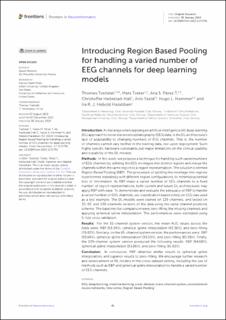Introducing Region Based Pooling for handling a varied number of EEG channels for deep learning models
Tveitstøl, Thomas; Tveter, Mats; Pérez Teseyra, Ana Silvina; Hatlestad-Hall, Christoffer; Yazidi, Anis; Hammer, Hugo Lewi; Haraldsen, Ira Hebold
Peer reviewed, Journal article
Published version
Permanent lenke
https://hdl.handle.net/11250/3120751Utgivelsesdato
2023Metadata
Vis full innførselSamlinger
Sammendrag
Introduction: A challenge when applying an artificial intelligence (AI) deep learning
(DL) approach to novel electroencephalography (EEG) data, is the DL architecture’s
lack of adaptability to changing numbers of EEG channels. That is, the number
of channels cannot vary neither in the training data, nor upon deployment. Such
highly specific hardware constraints put major limitations on the clinical usability
and scalability of the DL models.
Methods: In this work, we propose a technique for handling such varied numbers
of EEG channels by splitting the EEG montages into distinct regions and merge the
channels within the same region to a region representation. The solution is termed
Region Based Pooling (RBP). The procedure of splitting the montage into regions
is performed repeatedly with different region configurations, to minimize potential
loss of information. As RBP maps a varied number of EEG channels to a fixed
number of region representations, both current and future DL architectures may
apply RBP with ease. To demonstrate and evaluate the adequacy of RBP to handle
a varied number of EEG channels, sex classification based solely on EEG was used
as a test example. The DL models were trained on 129 channels, and tested on
32, 65, and 129-channels versions of the data using the same channel positions
scheme. The baselines for comparison were zero-filling the missing channels and
applying spherical spline interpolation. The performances were estimated using
5-fold cross validation.
Results: For the 32-channel system version, the mean AUC values across the
folds were: RBP (93.34%), spherical spline interpolation (93.36%), and zero-filling
(76.82%). Similarly, on the 65-channel system version, the performances were: RBP
(93.66%), spherical spline interpolation (93.50%), and zero-filling (85.58%). Finally,
the 129-channel system version produced the following results: RBP (94.68%),
spherical spline interpolation (93.86%), and zero-filling (91.92%).
Conclusion: In conclusion, RBP obtained similar results to spherical spline
interpolation, and superior results to zero-filling. We encourage further research
and development of DL models in the cross-dataset setting, including the use of
methods such as RBP and spherical spline interpolation to handle a varied number
of EEG channels.

